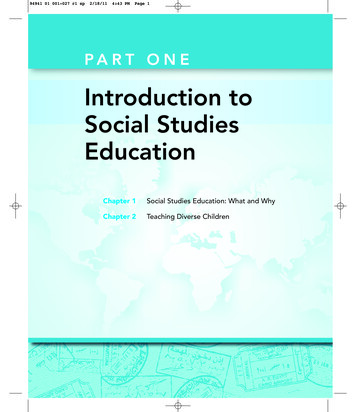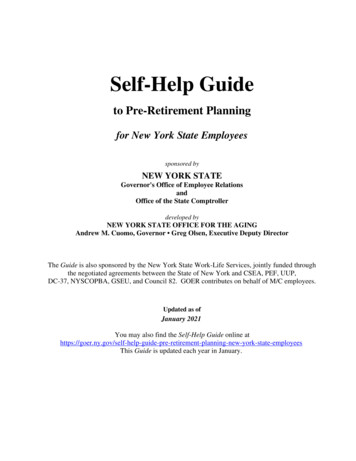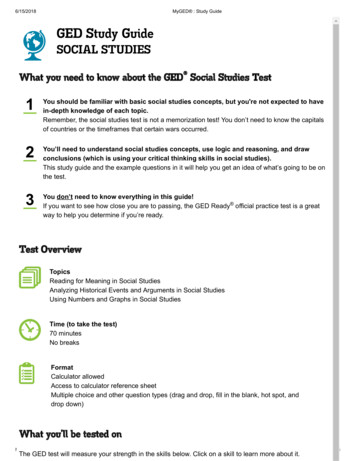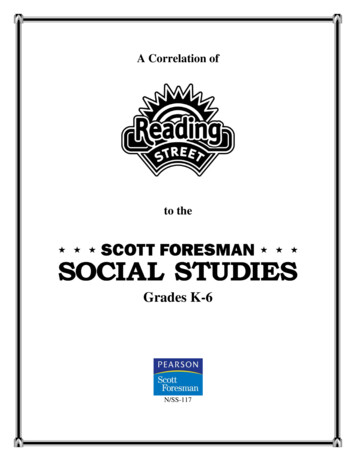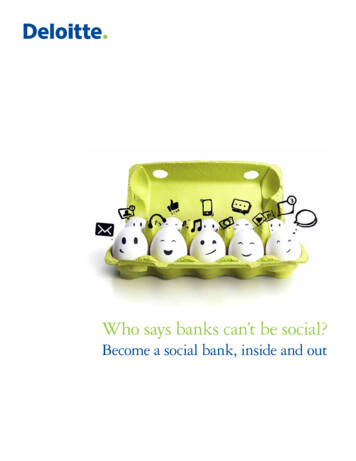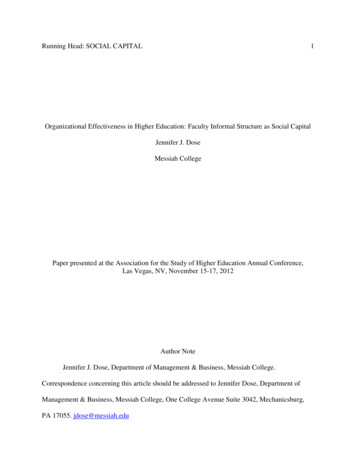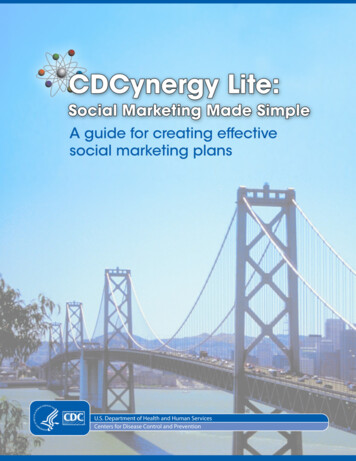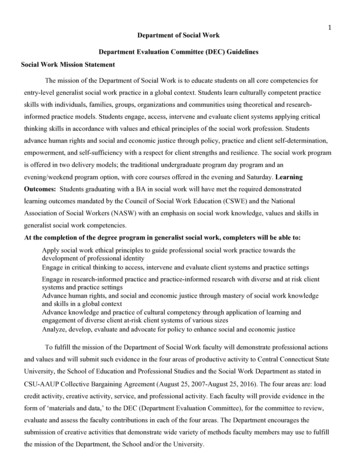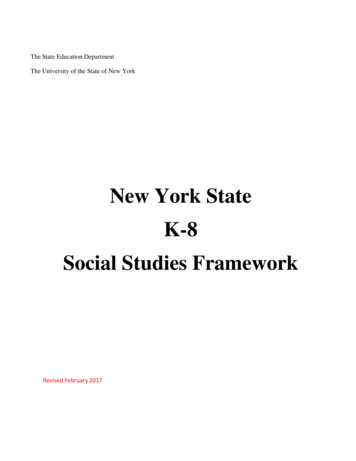
Transcription
The State Education DepartmentThe University of the State of New YorkNew York StateK-8Social Studies FrameworkRevised February 2017
ContentsGrades K – 4 . 3Social Studies Practices: Vertical Articulation Grades K-4 . 4Kindergarten . 12Common Core Learning Standards for English Language Arts and Literacy. 13Reading Standards for Informational Text . 13Writing Standards . 13Speaking and Listening Standards . 13Kindergarten: Social Studies Practices . 15Grade K: Self and Others . 16Grade 1 . 19Common Core Learning Standards for English Language Arts and Literacy. 20Reading Standards for Informational Text . 20Writing Standards . 20Speaking and Listening Standards . 21Grade 1: Social Studies Practices . 22Grade 1: My Family and Other Families, Now and Long Ago . 23Grade 2 . 27Common Core Learning Standards for English Language Arts and Literacy. 28Reading Standards for Informational Text . 28Writing Standards . 28Speaking and Listening Standards . 28Grade 2: Social Studies Practices . 30Grade 2: My Community and Other Communities . 32Grade 3 . 36Common Core Learning Standards for English Language Arts and Literacy. 37Reading Standards for Informational Text . 37Writing Standards . 37Speaking and Listening Standards . 38Grade 3: Social Studies Practices . 39Grade 3: Communities around the World . 41Grade 4 . 45Common Core Learning Standards for English Language Arts and Literacy. 46Reading Standards for Informational Text . 46Grades K-8Page 1
Writing Standards . 46Speaking and Listening Standards . 47Grade 4: Social Studies Practices . 49Grade 4: Unifying Themes Aligned to Key Ideas . 51Grade 4: New York State and Local History and Government . 52Grades 5-8 . 58Common Core Reading Standards for Literacy in History/Social Studies . 59Common Core Writing Standards for Literacy in History/Social Studies, Science, and Technical Subjects . 59Common Core Standards for Speaking and Listening. 61Vertical Articulation and Progression of Social Studies Practices Grades 5-8 . 62Grade 5 . 70Grade 5: Social Studies Practices . 71Grade 5: Unifying Themes Aligned to Key Ideas . 73Grade 5: The Western Hemisphere. 74Grade 6 . 78Grade 6: Social Studies Practices . 79Grade 6: Unifying Themes Aligned to Key Ideas . 81Grade 6: The Eastern Hemisphere . 82Grades 7 and 8: History of the United States and New York State . 87Grade 7 . 88Grade 7: Social Studies Practices . 89Grade 7: Unifying Themes Aligned to Key Ideas . 91Grade 7 History of the United States and New York State I . 92Grade 8 . 99Grade 8: Social Studies Practices . 100Grade 8: Unifying Themes Aligned to Key Ideas . 102Grade 8 History of the United States and New York State II. 103Grades K-8Page 2
Grades K – 4Grades K-8Page 3
Social Studies Practices: Vertical Articulation Grades K-4Social StudiesPracticesGathering,Interpreting andUsing EvidenceChronologicalReasoning andCausationGrades K-8K1234Ask questions.Developquestions abouthis/her family.Developquestions aboutthe community.Develop questionsabout a worldcommunity.Recognize formsof evidence usedto make meaningin social studies.Recognizedifferent forms ofevidence used tomake meaning insocial studies(including sourcessuch as art andphotographs,artifacts, oralhistories, maps,and graphs).Recognize and usedifferent forms ofevidence to makemeaning in socialstudies (includingprimary andsecondarysources, such asart andphotographs,artifacts, oralhistories, maps,and graphs).Identify theauthor or creatorof a book or map.Identify thecreator and/orauthor of differentforms ofevidence.Recognizedifferent forms ofevidence used tomake meaning insocial studies(includingprimary andsecondarysources, such asart andphotographs,artifacts, oralhistories, maps,and graphs).Identify andexplain creationand/or authorship,purpose, andformat ofevidence.Develop questionsabout New YorkState and itshistory,geography,economics, and/orgovernment.Recognize, use,and analyzedifferent forms ofevidence to makemeaning in socialstudies (includingprimary andsecondary sources,such as art andphotographs,artifacts, oralhistories, maps,and graphs).Identify opinionsexpressed byothers.Identify opinionsof others.Identify andexplain creationand/or authorship,purpose, andformat ofevidence. Whereappropriate,identify point ofview.Identifyarguments ofothers.Identify andexplain creationand /or authorship,purpose, andformat ofevidence. Whereappropriateidentify point ofview and bias.Identifyarguments ell animportant lifeevent insequential order.Identifyarguments ofothers.Createunderstanding ofthe past by usingprimary andsecondarysources.Createunderstanding ofthe past by usingprimary andsecondarysources.Createunderstanding ofthe past by usingand analyzingprimary andsecondarysources.Createunderstanding ofthe past by usingand analyzingprimary andsecondary sources.Retell a real-lifefamily event insequential order.Retell acommunity eventin sequentialorder.Explain how threeor more events arerelated to oneanother.Explain howevents are relatedchronologically toone another.Page 4
Social StudiesPracticesChronologicalReasoning andCausationK1234Understand theconcept of timemeasurements,including daysand weeks.Understand theconcept of timemeasurements,including days,weeks, monthsand years.Understand theconcept of timemeasurements,includingminutes, hours,days, weeks,months, years.Employmathematicalskills to measuretime in years andcenturiesEmploymathematicalskills to measuretime in years andcenturies.Understand thedifferencebetween B.C.E.and C.E. Identifythe chronologicalsignificance ofdata presented intime lines, withteacher support.Identify causesand effects, usingan example fromhis/her familylife.Identify causesand effects, usingexamples fromhis/her familylife.Identify causesand effects, usingexamples fromhis/her family lifeor from thecommunity.Identify causesand effects, usingexamples fromhis/her life orfrom a currentevent or history.Identify therelationshipbetween multiplecauses andmultiple effects,using examplesfrom his/her lifeand from a currentevent or history.Distinguishbetween long-termand immediatecauses and effectsof an event fromhis/her life orcurrent events orhistory.Grades K-8Identify changeover time inhis/her life.Identify changeover time inhis/her family.Identify changesover time inhis/hercommunity.Recognizecontinuity andchange overperiods of time.Recognizedynamics ofhistoricalcontinuity andchange overperiods of time.Identify events ofthe past, present,and future inhis/her life.Identify events ofthe past, present,and future inhis/her familylife.Identify events ofthe past, present,and future inhis/hercommunity life.Recognize periodsof time, such asdecades andcenturies.Use periods oftime, such asdecades andcenturies to putevents intochronologicalorder.Page 5
Social StudiesPracticesK1234ChronologicalReasoning andCausationIdentify routinesand commonoccurrences inhis/her life.Recognize andidentify patternsof continuity inhis/her family.Recognize andidentify patternsof continuity andchange incommunities.Recognize andidentify patternsof continuity andchange in worldcommunities.Recognize andidentify patternsof continuity andchange in NewYork State.Comparison andContextualizationIdentifysimilarities anddifferencesbetween homeand school.Identifysimilarities ities anddifferencesbetweencommunities.Identify a worldregion bydescribing acharacteristic thatplaces within ithave in common.Identify a regionin New York Stateby describing acharacteristic thatplaces within ithave in common,and then compareit to other regions.Identifysimilarities and/ordifferencesbetween him/herand others.Identifysimilarities and/ordifferencesbetween him/herand others withdetail.Identifysimilarities and/ordifferencesbetween his/hercommunity andothercommunities.Identify multipleperspectives bycomparing andcontrasting pointsof view indiffering worldcommunities.Identify multipleperspectives froma historical event.Describe an eventin his/her life.Describe an eventin his/her family.Describe an eventin his/hercommunity.Describe ahistorical event ina worldcommunity.Describe andcompare NewYork Statehistorical events.Understand theconcepts ofgeography,economics, andhistory that applyto his/her family.Recognize therelationshipbetweengeography,economics, andhistory in his/hercommunity.Recognize therelationshipbetweengeography,economics, andhistory in worldcommunities.Recognize therelationshipbetweengeography,economics, andhistory in socialstudies.Describe ahistoricaldevelopment inhis/hercommunity withspecific details,including timeand place.Describe ahistoricaldevelopment in aworld communitywith specificdetails, includingtime and place.Describe historicaldevelopments inNew York Statewith specificdetails, includingtime and place.Grades K-8Page 6
Social StudiesPracticesGeographicReasoningGrades K-8K1234Ask geographicquestions aboutwhere places arelocated and whythey are locatedthere, usinglocation termsand geographicrepresentations,such as maps,photographs,satellite images,and models.Ask geographicquestions aboutwhere places arelocated and whythey are locatedthere, usinglocation termsand geographicrepresentations,such as maps,photographs,satellite images,and models.Describe whereplaces are inrelation to eachother.Ask geographicquestions aboutwhere places arelocated and whythey are locatedthere, usinglocation termsand geographicrepresentations,such as maps,photographs,satellite images,and models.Describe whereplaces are inrelation to eachother and describeconnectionsbetween places.Ask geographicquestions aboutwhere places arelocated and whythey are locatedthere, usinglocation terms andgeographicrepresentations,such as maps,photographs,satellite images,and models.Describe whereplaces are inrelation to eachother and describeconnectionsbetween places.Use location termsand geographicrepresentations,such as maps,photographs,satellite images,and models, todescribe whereplaces are inrelation to eachother, to describeconnectionsbetween places,and to evaluate thebenefits ofparticular placesfor purposefulactivities.Identify naturalevents or physicalfeatures, such asland, water, air,and wind.Identify humanactivities andhuman-madefeatures; identifynatural events orphysical features.Distinguishhuman activitiesand human-madefeatures fromnatural events orphysical features.Distinguishhuman activitiesand human-madefeatures from“environments”(natural events orphysicalfeatures—land,air, and water—that are notdirectly made byhumans).Distinguish humanactivities andhuman-madefeatures from“environments”(natural events orphysical features—land, air, andwater—that are notdirectly made byhumans).Describe howenvironmentaffects his/heractivities.Describe howenvironmentaffects his/her andother people’sactivities.Describe howhis/her actionsaffect theenvironment ofthe community;describe how theenvironment ofthe communityaffects humanactivities.Describe howhuman activitiesaffect theenvironment of aworld community;describe how theenvironment of aspecific worldcommunity affectsthe humanactivities in thatcommunity.Identify howenvironmentsaffect humanactivities and howhuman activitiesaffect physicalenvironments.Page 7
Social StudiesPracticesGeographicReasoningEconomics andEconomic SystemsGrades K-8K1234Identify a pattern.Identify a patternand a process.Recognize aprocess thatapplies topopulation, and aresulting pattern.Recognize aprocess thatapplies topopulation, and aresulting pattern.Recognizerelationshipsbetween patternsand processes.Identify a humanactivity thatchanged a place.Describe howhuman activitiesalter places.Describe howhuman activitiesalter places in acommunity.Describe howhuman activitiesalter places andregions.Describe howhuman activitiesalter places andregions.Identify examplesof scarcity andchoices made dueto scarcity.Explain howscarcity affectschoices made byfamilies andcommunities, andidentify costs andbenefitsassociated withthese choices.Explain howscarcitynecessitatesdecision making;identify thebenefits and costsof decisions.Examine howscarcity affects thedecisions aboutthe use ofresources bypeople andgovernments;examine the costsand benefits ofeconomicdecisions.Explain howscarcitynecessitatesdecision making;compare the costsand benefits ofindividual andeconomicdecisions.Identify examplesof goods andservices.Distinguishbetween aconsumer and aproducer and theirrelationship togoods andservices.Describe theresources used toproduce goodsand provideservices in thelocal community.Identify thevariety ofresourcesavailable in aparticular worldcommunity usedto produce goodsand/or provideservices.Identify whatmoney is and howit is used insociety.Explain howpeople earnmoney andexplain otherways that peoplereceive money.Describe the roleof banks, saving,and borrowing inthe economy.Identify productsfound in worldcommunities andthe various waysthat people inthose communitiespay for products.Distinguishbetween thevarious types ofresources (humancapital, physicalcapital, andnatural resources)required toproduce goods andservices.Explain the role ofmoney in makingexchange easier;examine the roleof corporationsand labor unionsin an economy.Page 8
Social StudiesPracticesK1Economics andEconomic Systems23Describe thegoods andservices thatpeople in thelocal communityproduce and thosethat are producedin othercommunities.Examine thegoods andservices providedby worldcommunities;describe whatgoods andservices a worldcommunity tradeswith other worldcommunities.4Explain whyindividuals andbusinessesspecialize andtrade.Explain themeaning ofunemployment.Civic ParticipationGrades K-8Demonstraterespect for therights of others.Demonstraterespect for therights of others indiscussions,regardless ofwhether oneagrees with theother viewpoints.Participate inactivities thatfocus on aclassroom orschool issue orproblem.Participate inactivities thatfocus on aclassroom orschool issue orproblem.Identify goodsand services thatgovernmentprovides and therole of taxes.Explore the typesof governments inworldcommunities andthe services thatthey provide tocitizens.Explain the waysthat thegovernment paysfor the goods andservices that itprovides,including taxrevenue.Demonstraterespect for therights of others indiscussions andclassroomdebates,regardless ofwhether oneagrees with theother viewpoints.Participate inactivities thatfocus on aclassroom,school, or localcommunity issueor problem.Demonstraterespect for therights of others indiscussions andclassroomdebates,regardless ofwhether oneagrees with theother viewpoints.Participate inactivities thatfocus on aclassroom, school,or worldcommunity issueor problem.Demonstraterespect for therights of others indiscussions andclassroom debates,regardless ofwhether oneagrees with theother viewpoints.Participate inactivities thatfocus on aclassroom, school,community, state,or national issueor problem.Page 9
Social StudiesPracticesK1Civic ParticipationGrades K-8234Identify theelements of thecommunity’spolitical system.Identify differenttypes of politicalsystems found inworldcommunities.Identify differenttypes of politicalsystems used atvarious times inNew York Statehistory and, whereappropriate, inUnited Stateshistory.Identify the roleof the individualin classroomparticipation.Identify the roleof the individualin classroom andschoolparticipation.Identify the roleof the individualin classroom,school, and localcommunityparticipation.Identifyopportunities forand the role of theindividual insocial andpoliticalparticipation inthe school, localcommunity, orworld community.Identifyopportunities forand the role of theindividual insocial and politicalparticipation in theschool, local,and/or statecommunity.Show respect inissues involvingdifference andconflict.Show respect inissues involvingdifference andconflict;participate in theresolution ofdifferences andconflict.Show respect inissues involvingdifference andconflict;participate innegotiating andcompromising inthe resolution ofdifferences andconflict.Show respect inissues involvingdifference andconflict;participate innegotiating andcompromising inthe resolution ofdifferences andconflict.Show respect inissues involvingdifference andconflict;participate innegotiating andcompromising inthe resolution ofdifferences andconflict.Identify situationsin which socialactions arerequired.Identify situationsin which socialactions arerequired.Identify situationsin which socialactions arerequired.Identify situationsin which socialactions arerequired andsuggest actions.Identify situationsin which socialactions arerequired andsuggest actions.Page 10
Social StudiesPracticesCivic ParticipationGrades K-8K1234Identify theschool principaland his/her rolewithin the school.Identify thepresident of theUnited States andthe schoolprincipal and olitical leaders(e.g., mayor), thegovernor of NewYork State, andthe president ofthe United Statesand theirleadershipresponsibilities.Identify leaders ofworldcommunities andthe president ofthe United States;identifysimilarities anddifferences intheir roles.Identify people inpositions of powerand how they caninfluence people’srights andfreedom.Identify andfollow rules in theclassroom andschool.Identify rightsandresponsibilities inthe classroom andschool.Identify rightsandresponsibilities inthe classroom,school, andcommunity.Identify rights andresponsibilities ofcitizens in thelocal communityand compare themto those in worldcommunities.Identify rights andresponsibilities asa citizen of thecommunity andthe state.Page 11
KindergartenGrades K-8Page 12
Common Core Learning Standards for English Language Arts and LiteracyReading Standards for Informational TextKey Ideas and Details1. With prompting and support, ask and answer questions about key details in a text.2. With prompting and support, identify the main topic and retell key details of a text.3. With prompting and support, describe the connection between two individuals, events, ideas, or pieces ofinformation in a text.Craft and Structure4. With prompting and support, ask and answer questions about unknown words in a text.5. Identify the front cover, back cover, and title page of a book.6. Name the author and illustrator of a text and define the role of each in presenting the ideas or information in atext.Integration of Knowledge and Ideas7. With prompting and support, describe the relationship between illustrations and the text in which they appear(e.g., what person, place, thing, or idea in the text an illustration depicts).8. With prompting and support, identify the reasons an author gives to support points in a text.9. With prompting and support, identify basic similarities and differences between two texts on the same topic(e.g., in illustrations, descriptions, or procedures).Range of Reading and Level of Text Complexity10. Actively engage in group reading activities with purpose and understanding.Writing StandardsText Types and Purposes1. Use a combination of drawing, dictating, and writing to compose opinion pieces in which they tell a reader thetopic or the name of the book they are writing about and state an opinion or preference about the topic or book(e.g., My favorite book is . . .).2. Use a combination of drawing, dictating, and writing to compose informative/explanatory texts in which theyname what they are writing about and supply some information about the topic.3. Use a combination of drawing, dictating, and writing to narrate a single event or several loosely linked events,tell about the events in the order in which they occurred, and provide a reaction to what happened.Production and Distribution of Writing4. With guidance and support from adults, respond to questions and suggestions from peers and add details tostrengthen writing as needed.5. With guidance and support from adults, explore a variety of digital tools to produce and publish writing,including in collaboration with peers.Research to Build and Present Knowledge6. Participate in shared research and writing projects (e.g., explore a number of books by a favorite author andexpress opinions about them).7. With guidance and support from adults, recall information from experiences or gather information fromprovided sources to answer a question.Speaking and Listening StandardsComprehension and Collaboration1. Participate in collaborative conversations about kindergarten topics and texts with peers, diverse partners,and adults in small and larger groups.Grades K-8Page 13
a. Follow agreed-upon rules for discussions (e.g., listening to others and taking turns speaking about thetopics and texts under discussion).b. Continue a conversation through multiple exchanges.c. Seek to understand and communicate with individuals from different cultural backgrounds.2. Confirm understanding of a text read aloud or information presented orally or through other media byasking and answering questions about key details and requesting clarification if something is notunderstood.3. Ask and answer questions in order to seek help, get information, or clarify something that is not understood.Presentation of Knowledge and Ideas4. Describe familiar people, places, things, and events and, with prompting and support, provide additionaldetail.5. Add drawings or other visual displays to descriptions as desired to provide additional detail.6. Speak audibly and express thoughts, feelings, and ideas clearly.Grades K-8Page 14
Kindergarten: Social Studies PracticesA. Gathering, Interpreting and Using Evidence1. Ask questions.2. Recognize forms of evidence used to make meaning in social studies.3. Identify the author or creator of a book or map.4. Identify opinions expressed by others.B. Chronologica
in social studies. Recognize different forms of evidence used to make meaning in social studies (including sources such as art and photographs, artifacts, oral histories, maps, and graphs). Recognize different forms of evidence used to make meaning in social studies (including pr
